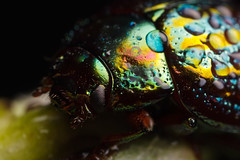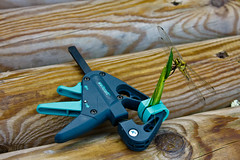Back in the early summer of 07 I was out at Lago d'Averno (my favorite dragonfly hunting ground) shooting in +30C degree heat (high 80s to low 90s F for the metric impaired) with a Canon 20D, a 100mm macro lens + tubes, and an MT-24EX all supported on a BushHawk shoulder mount. A lot of weight to put on a camera strap, especially one that I wasn't checking on a regular basis to make sure it was still secure. I stopped to wipe the sweat from my face and let the rig dangle by the strap and as my luck would have it gravity got the best of my rig -it landed flat against the side of the BushHawk with an ugly thud...
When I first picked up my gear and brushed the dust off of it the MT-24EX didn't work. The force of the impact drove the batteries so hard against the internal contacts in the battery compartment they were flattened and no longer touching the batteries. The hot shoe on the 20D also took a lot of damage and eventually failed a few months later.
When I got home I bent the battery contacts out and managed to get the MT-24EX working again, but since that fall two years ago I knew that I was using that flash on borrowed time. About two weeks ago the "A" flash head started to intermittently fail, but because the light looked good when it did work I knew the controller was going bad. Weather due to the gravity test two years ago or shooting in wet early morning conditions this year I don't know, but the end result was the same -I couldn't rely on it anymore.
Since it failed I've been experimenting with mounting a Canon 270EX on the MT-24EX's flash mount, but with limited success. The image included with this post is a test shot, and it's pretty dark. Since I took that shot I've redesigned the flash mount so I could get a lower angle between the flash and the subject, but it's just not the same as having a dual light source. If I put the 270EX on a flash bracket, with a bigger diffuser, then the light would be a lot more even and the shadows less severe. But I don't think it's going to work mounted right at the end of my MPE-65mm -I can't make the diffuser larger without bumping the subject with it at high magnification.
So at this point my options are pretty limited: Either use the MR-14EX that's been collecting dust since I picked up the MT-24EX, use a 580EX II on a flash flash bracket (not practical for my style of shooting), or buy a new MT-24EX. That last option presents a problem: Canon has updated every flash in their lineup except the macro flashes. I've got no proof, but it just makes sense that they're going to come out with a new macro flash. I'd hate to shell out +600 USD just to see Canon announce a new unit sometime between now and next fall...
So I'm going to see what I can do with the MR-14EX, and as long as the natural light is good shoot more natural light closeups. Although I don't get as much feedback on my closeup photography as I do the high mag shots I like shooting closeups in natural light more than shooting macro.
Time to break out the gaffers tape, channel Martha Stewart, and see what I can do to reduce those half moon specular highlights that haunt the MR-14EX :)
For those of you wondering about the performance of the 270EX it's actually pretty good as far as the flash recycle time goes: Almost instantaneous all the way out to 5x and F10. The E-TTL metering with it is also a lot more accurate than the MT-24EX. So I can't discount it completely as a potential light source for macro -I just can't get it to work in the way that I want to use it...
Monday, June 8, 2009
Friday, May 29, 2009
Water Drop How To
Strobist has an excellent piece on How to Photograph Water Drops with One Speedlight and there is a tutorial video embedded in the article that's excellent for beginners wanting to get into water drop shooting. There's also another video that I'm including here, some high speed motion capture of water drops that's incredible!
Tuesday, May 26, 2009
Early Morning Macro
Although I'm not a fan of dew covered critter shots I seem to be taking more and more of them lately. It's easier to find willing subjects, like this pair of mating Soldier Beetles, early in the day when they are still a little lethargic and haven't had a chance to warm up and dry out. Later in the day that same pair wouldn't let me get anywhere near them.
When shooting mating pairs it's best to get both of their leading eyes in focus, so look for angles that will allow you to place the area of acceptable focus for maximum detail. In this shot I was holding onto the grass stalk just behind them with my left index finger and thumb so all I had to do was slowly rotate the stalk until I got an angle that worked. With the lens resting on my left hand it was easy to keep the scene steady and to get the sharpness I wanted even though I had the MPE-65mm stopped down to F13.
Sorry about the title of the shot -it was the first thing that popped into my head when I was looking at them through the view finder :)
When shooting mating pairs it's best to get both of their leading eyes in focus, so look for angles that will allow you to place the area of acceptable focus for maximum detail. In this shot I was holding onto the grass stalk just behind them with my left index finger and thumb so all I had to do was slowly rotate the stalk until I got an angle that worked. With the lens resting on my left hand it was easy to keep the scene steady and to get the sharpness I wanted even though I had the MPE-65mm stopped down to F13.
Sorry about the title of the shot -it was the first thing that popped into my head when I was looking at them through the view finder :)
Friday, May 22, 2009
Happy Accidents
One of the things that I'm trying to do this year is shoot in different places, to not get in the habit of looking in the same spots all the time because it's a great way to shoot the same subjects... boring...
So I went to the opposite end of Lago d'Averno hoping to see something new but was walking back to my car empty handed when I spotted some mature dragonflies trying to warm up and dry off. I'm not sure where they were perching for the night, but they were definitely making their way back toward the water when I stopped to photograph the critter in this post. Concerned that it was too awake to let me cut the perch and move it, and the simple fact that I'd be cutting a flower that was part of a recent landscaping project, I decided to shoot the damselfly by holding onto the perch with my left hand and just rest the lens on that same hand to keep everything steady. But the critter was at the end of a flower stalk so I had to grab onto the stalk behind it.
Now I have a new technique to add to my bag of tricks :)
Since my fingers are behind the damselfly they acted as a reflector for the light from the flash -but because they are almost twice as far from the light as the critter they came out about a stop under exposed and the color saturated. Instead of a black background I got a nice bright one that really makes the critter stand out.
So I went to the opposite end of Lago d'Averno hoping to see something new but was walking back to my car empty handed when I spotted some mature dragonflies trying to warm up and dry off. I'm not sure where they were perching for the night, but they were definitely making their way back toward the water when I stopped to photograph the critter in this post. Concerned that it was too awake to let me cut the perch and move it, and the simple fact that I'd be cutting a flower that was part of a recent landscaping project, I decided to shoot the damselfly by holding onto the perch with my left hand and just rest the lens on that same hand to keep everything steady. But the critter was at the end of a flower stalk so I had to grab onto the stalk behind it.
Now I have a new technique to add to my bag of tricks :)
Since my fingers are behind the damselfly they acted as a reflector for the light from the flash -but because they are almost twice as far from the light as the critter they came out about a stop under exposed and the color saturated. Instead of a black background I got a nice bright one that really makes the critter stand out.
Saturday, May 9, 2009
Field Studio In Action
I found this immature dragonfly early in the morning when it was too cold and wet to move so it was pretty easy to cut the grass it was perched on, carry it to a nearby park bench, and put it in the wood clamp for some field studio work.
The first sample image from that shoot is at F13 and 2.5x and the second is at F10 and 5x.
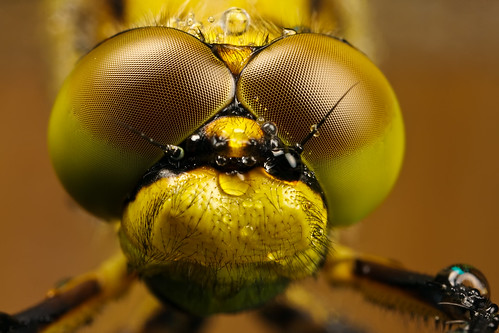
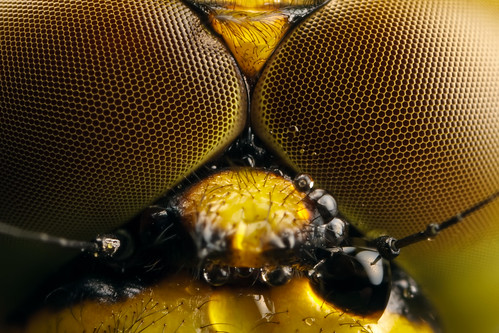
The first sample image from that shoot is at F13 and 2.5x and the second is at F10 and 5x.


Wednesday, May 6, 2009
Field Studio Gear
This morning I shot a dragonfly that was too cold and damp to get away from me. I started out photographing the critter where I found it but quickly realized that it just wasn't practical -there was just too much tall grass in the way and I'd be getting it in just about every frame. Plus I wanted to get some high magnification shots and it just wasn't gonna happen unless I moved the subject to another area. So I cut the grass stem that it was perched on and carried it to a stone wall close where I found it. Then, using the wood clamp pictured to the right, I secured the dragonfly's perch.
With the dragon and its perch sitting in an area where I could comfortably work it was easy to brace the lens with my left hand by putting it on the wall next to the clamp. Here are two frames from the session, the first at 3x and F13 and the second at 5x and F10:
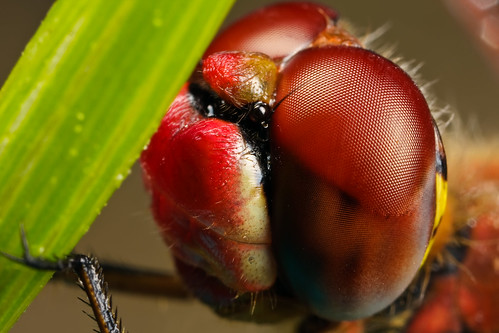

Sharp, studio quality, images at the edge of a parking lot...
With the dragon and its perch sitting in an area where I could comfortably work it was easy to brace the lens with my left hand by putting it on the wall next to the clamp. Here are two frames from the session, the first at 3x and F13 and the second at 5x and F10:


Sharp, studio quality, images at the edge of a parking lot...
Tuesday, May 5, 2009
Capitilize on Opportunities
I take some abuse through the year from people who get tired of seeing me post a lot of the same subjects, like the solitary bee that I'm including with this post. But I don't let it get to me, and I certainly don't let it influence what I do and don't photograph. A lot of what I shoot is seasonal and transitory -if I don't photograph the critters as I find them then I'll never have any photos. It's not like I get to choose what's available...
I also used this bee to illustrate another key point: Sometimes I''l find an insect for the first time, one I've never seen before, that has just emerged and since the weather is still cool I get one or two days to photograph them before they move on to another area where I can't get to them or they tunnel into the ground and build nests. So the only time I'll see them again is when it's warm and they are hyper active. So it's now or never, and I'd rather take the photos when I can get them because there's just no way an active bee is going to let me get close enough for a four times life size shot like this one.
If I didn't capitalize on opportunities then I wouldn't have anything in my gallery...
As for the deconstruction on this photo it's really quite simple: The bee has recently emerged (I think it was the afternoon that I found it) and the temps were cool, somewhere around 14C (57F) so the critter is pretty immobile. I've got one flash head of the MT-24EX set to the 11 O' clock position relative to me acting as the key light and I'm using a Kaiser adjustable flash shoe to get it a little higher than it would normally be if I had just connected it to the Canon flash mount that comes with the MT-24EX. If I didn't elevate one of the flash heads then both lights would be hitting the subject at the same relative angle so any reflective surface is going to be twice as bright. But with one head elevated I get a break on the specular highlights and the shadows are deeper as well. If you look closely at the eyes you can see that they are actually convex and it shows up well because the light does not wrap around the lenses, or the subject, evenly due to the extending the key.
The other flash head is mounted directly to the flash mount at the 2 O 'clock position and it's acting as my fill. No ratio control (not necessary due to the position of the flash heads) and I'm diffusing the light though a modified Gary Fong Puffer diffuser. The camera is set to manual mode F10, ISO 100 (the shutter is at 1/250 but that's irrelevant since the ambient light level is too low to be recorded by the sensor). The MPE-65mm was set to 4x, and I moved the bee from were I found it sleeping in a flower to a low stone wall. Resting my left hand on the wall I held the lens with my thumb and index finger to keep it steady while I looked for an angle that would make the most of what little depth I had. I wanted a 5x shot but the bee woke up and took off before I could get it. When I went back the next day the only bees I found were deep inside the flowers and they were covered in pollen -not as "clean" looking as the one you see here. The day after that the bees were gone. Maybe next time... :)
I also used this bee to illustrate another key point: Sometimes I''l find an insect for the first time, one I've never seen before, that has just emerged and since the weather is still cool I get one or two days to photograph them before they move on to another area where I can't get to them or they tunnel into the ground and build nests. So the only time I'll see them again is when it's warm and they are hyper active. So it's now or never, and I'd rather take the photos when I can get them because there's just no way an active bee is going to let me get close enough for a four times life size shot like this one.
If I didn't capitalize on opportunities then I wouldn't have anything in my gallery...
As for the deconstruction on this photo it's really quite simple: The bee has recently emerged (I think it was the afternoon that I found it) and the temps were cool, somewhere around 14C (57F) so the critter is pretty immobile. I've got one flash head of the MT-24EX set to the 11 O' clock position relative to me acting as the key light and I'm using a Kaiser adjustable flash shoe to get it a little higher than it would normally be if I had just connected it to the Canon flash mount that comes with the MT-24EX. If I didn't elevate one of the flash heads then both lights would be hitting the subject at the same relative angle so any reflective surface is going to be twice as bright. But with one head elevated I get a break on the specular highlights and the shadows are deeper as well. If you look closely at the eyes you can see that they are actually convex and it shows up well because the light does not wrap around the lenses, or the subject, evenly due to the extending the key.
The other flash head is mounted directly to the flash mount at the 2 O 'clock position and it's acting as my fill. No ratio control (not necessary due to the position of the flash heads) and I'm diffusing the light though a modified Gary Fong Puffer diffuser. The camera is set to manual mode F10, ISO 100 (the shutter is at 1/250 but that's irrelevant since the ambient light level is too low to be recorded by the sensor). The MPE-65mm was set to 4x, and I moved the bee from were I found it sleeping in a flower to a low stone wall. Resting my left hand on the wall I held the lens with my thumb and index finger to keep it steady while I looked for an angle that would make the most of what little depth I had. I wanted a 5x shot but the bee woke up and took off before I could get it. When I went back the next day the only bees I found were deep inside the flowers and they were covered in pollen -not as "clean" looking as the one you see here. The day after that the bees were gone. Maybe next time... :)
Subscribe to:
Posts (Atom)

